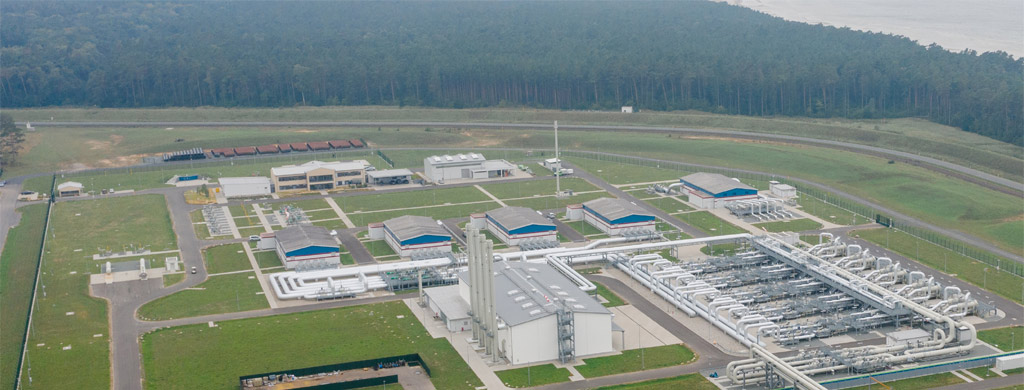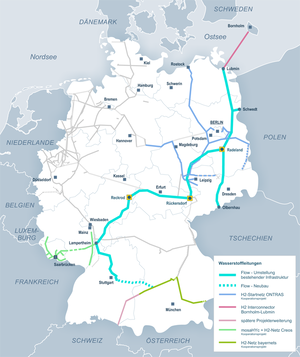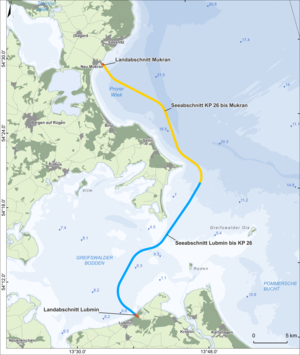GASCADE has completed the construction of the approximately 50-kilometre-long Ostsee Anbindungsleitung (OAL) in January 2024. The offshore pipeline will connect the planned liquefied natural gas (LNG) terminal in the port of Mukran with the German pipeline network in Lubmin.
The planned LNG terminal in Mukran includes two FSRUs (Floating Storage and Regasification Units). The LNG will be regasified on these special ships. The developer of the LNG terminal is Deutsche ReGas. Commissioning is planned for winter 2023/24. As the transmission system operator, GASCADE is obliged to connect the terminal to the German gas transmission system.
With the EUGAL and OPAL long-distance pipelines, substantial transport capacities can be provided in Lubmin to transport the gas from the coast in the north-east to the main centres of consumption in Germany as well as in Central and South-Eastern Europe.
Green perspective hydrogen – local and national
In the short term, the OAL strengthens security of supply by feeding regasified LNG into the gas grid. In the medium term, it is possible to convert the OAL to the transport of hydrogen. In the future, green hydrogen can then be fed into the German hydrogen core network via the entry point in Mukran. OAL can thus make an important contribution on the way to CO2 neutrality. This is because the Lubmin site, as the OAL's destination point, will also play a central role in the development of the German hydrogen network.
From here, green hydrogen produced or landed in and around the Baltic Sea is to be transported southwards to industrial consumption centres in the east and in southern Hesse and Baden-Württemberg as part of the Flow – making hydrogen happen project. Flow – making hydrogen happen is part of the German hydrogen core network.
On a local level, the OAL offers the port of Mukran and the island of Rügen an economic perspective in a future climate-neutral economy. The expansion of the port in the course of the OAL creates fundamental prerequisites for this. The need to transport the hydrogen generated by wind energy in the Baltic Sea, for example, will increase in the future. A stable infrastructure between the ports of Lubmin and Mukran will therefore become even more important.
The hydrogen transport pipeline between the port of Rostock and the pipeline system in the Lubmin area, which is planned as part of the German hydrogen core network, will make a significant contribution to strengthening the importance of the eastern German Baltic Sea ports.
Status of the approval procedure
With regard to approval, the OAL was divided into four sections, which are dealt with in independent procedures. The responsible approval authority for all construction sections is the Bergamt Stralsund.
The Lubmin land section was already approved on 13/02/2023 and is currently under construction. The crossing of the coastline is being carried out in a closed construction method using a microtunnel. The tunnel has already been completed.
The sea section from Lubmin to kilometre point 26 (KP 26) was approved on 21/08/2023. The draft of the planning approval decision was publically displayed until 18/08/2023.
The sea section from KP 26 to Mukran was approved on 25/10/2023. The application documents were put on public display until 07/08/2023.
The land section in Mukran was approved on 21/08/2023. The draft of the planning decision was publically displayed until 18/08/2023.
Data on approval procedures and construction measures:
- Lubmin land section (already completed)
- Approval by Bergamt Stralsund on 13/02/2023
- Completion in May 2023
- Sea section Lubmin to KP 26
- Approval by Bergamt Stralsund on 21/08/2023
- Sea section KP 26 to Mukran
- Approval by Bergamt Stralsund on 25/10/2023
- Land section Mukran
- Approval by Bergamt Stralsund on 21/08/2023
Construction and installation method
The pipe diameter of the OAL is 1.2 metres, and the pipe is made of high-strength steel with a wall thickness of at least 26.8 mm. To ensure that the pipeline lies securely and stably on the seabed, it is also provided with a concrete casing of 90 mm. The pipeline is buried along its entire length. The cover is 0.50 metres to 2.55 metres, depending on the local conditions.
Construction process for the sea sections
1. Construction of the pipe trench
When laying in an open trench, the pipeline is laid on the bottom of a previously constructed pipe trench. The OAL is buried along its entire length. The cover is 0.50 metres to 2.55 metres, depending on the local conditions. The dredging equipment used to construct the pipe trench and backfill it is determined by the depth of the water and the type of soil present. These are stilt pontoon dredgers, floating grab dredgers, hold suction dredgers and bucket chain dredgers. The dredged material is transported on transport vessels, so-called hopper barges, to an intermediate storage facility under water.
2. Welding and laying of the pipe string
On a special vessel, a laying barge, the individual pipes are welded together to form a pipe string. This pipe string is laid down by the laying barge in a controlled S-curve into the pipe trench on the seabed (S-lay process). This work is carried out under factory-like conditions, i.e. the welding of the individual pipes takes place unaffected by external weather conditions with consistently high quality and a very high production rate. The S-Lay method is the usual method for laying offshore pipelines with larger diameters over longer distances in moderate water depths.
In the final laying step, known as Above-Water-Tie-In (AWTI), individual pipe strings are joined together. Two AWTIs are carried out during the construction of the OAL. For this purpose, the laying barge has several hoists along its long side that can lift the two pipe strings and align them with each other. After completing the joint, the pipeline is laid down.
3. Backfilling and restoration of the seabed
After the OAL has been laid, the pipe trench is backfilled. For this purpose, a sand-gravel mixture is first used as embedding material. It is planned to surround the pipeline with embedding material to such an extent that positional stability is ensured in the subsequent steps. As a second layer, the material originally from the trench is backfilled. Finally, the reefs are restored by placing stones of a given size on the seabed.



